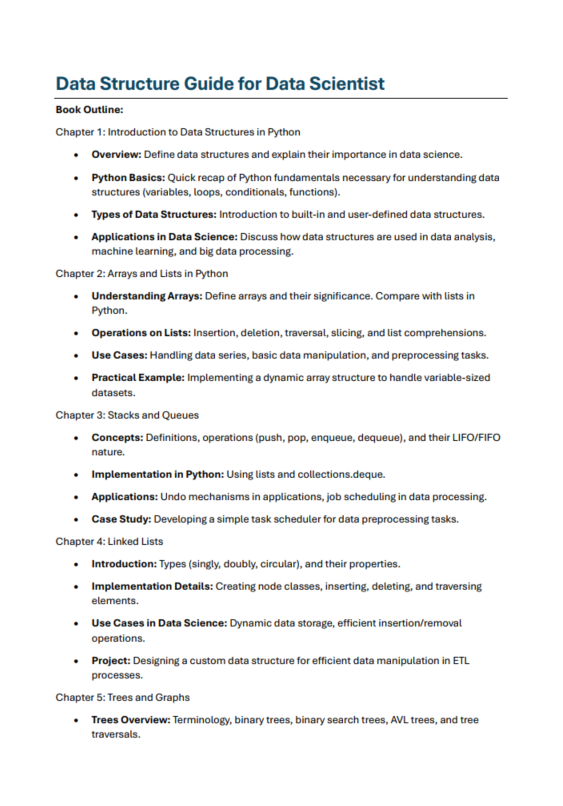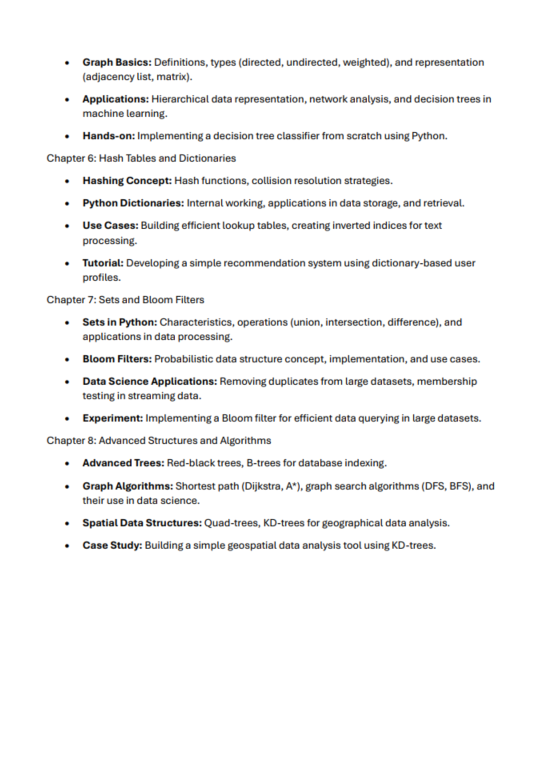 |
 |
|---|
Chapter 1: Introduction to Data Structures in Python
- Overview: Define data structures and explain their importance in data science.
- Python Basics: Quick recap of Python fundamentals necessary for understanding data structures (variables, loops, conditionals, functions).
- Types of Data Structures: Introduction to built-in and user-defined data structures.
- Applications in Data Science: Discuss how data structures are used in data analysis, machine learning, and big data processing.
Chapter 2: Arrays and Lists in Python
- Understanding Arrays: Define arrays and their significance. Compare with lists in Python.
- Operations on Lists: Insertion, deletion, traversal, slicing, and list comprehensions.
- Use Cases: Handling data series, basic data manipulation, and preprocessing tasks.
- Practical Example: Implementing a dynamic array structure to handle variable-sized datasets.
Chapter 3: Stacks and Queues
- Concepts: Definitions, operations (push, pop, enqueue, dequeue), and their LIFO/FIFO nature.
- Implementation in Python: Using lists and collections.deque.
- Applications: Undo mechanisms in applications, job scheduling in data processing.
- Case Study: Developing a simple task scheduler for data preprocessing tasks.
Chapter 4: Linked Lists
- Introduction: Types (singly, doubly, circular), and their properties.
- Implementation Details: Creating node classes, inserting, deleting, and traversing elements.
- Use Cases in Data Science: Dynamic data storage, efficient insertion/removal operations.
- Project: Designing a custom data structure for efficient data manipulation in ETL processes.
Chapter 5: Trees and Graphs
- Trees Overview: Terminology, binary trees, binary search trees, AVL trees, and tree traversals.
- Graph Basics: Definitions, types (directed, undirected, weighted), and representation (adjacency list, matrix).
- Applications: Hierarchical data representation, network analysis, and decision trees in machine learning.
- Hands-on: Implementing a decision tree classifier from scratch using Python.
Chapter 6: Hash Tables and Dictionaries
- Hashing Concept: Hash functions, collision resolution strategies.
- Python Dictionaries: Internal working, applications in data storage, and retrieval.
- Use Cases: Building efficient lookup tables, creating inverted indices for text processing.
- Tutorial: Developing a simple recommendation system using dictionary-based user profiles.
Chapter 7: Sets and Bloom Filters
- Sets in Python: Characteristics, operations (union, intersection, difference), and applications in data processing.
- Bloom Filters: Probabilistic data structure concept, implementation, and use cases.
- Data Science Applications: Removing duplicates from large datasets, membership testing in streaming data.
- Experiment: Implementing a Bloom filter for efficient data querying in large datasets.
Chapter 8: Advanced Structures and Algorithms
- Advanced Trees: Red-black trees, B-trees for database indexing.
- Graph Algorithms: Shortest path (Dijkstra, A*), graph search algorithms (DFS, BFS), and their use in data science.
- Spatial Data Structures: Quad-trees, KD-trees for geographical data analysis.
- Case Study: Building a simple geospatial data analysis tool using KD-trees.
